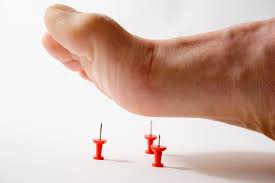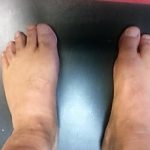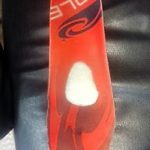Pain in the Ball of the Foot = Metatarsalgia
Pain in the ball of your foot is usually referred to as “Metatarsalgia”. In Latin, the word Metatarsal is used to describe the region of the foot that is equivalent to the palm of your hand. The suffix “algia” simply means pain. So the word Metatarsalgia means “Pain in the Metatarsal region”.
The Anatomy
You have 5 Metatarsal bones which are numbered according to which toes they form joints with. The first metatarsal forms a joint with the 1st toe (big toe), the second Metatarsal forms a joint with the second toe and so on. In Latin toes are called “Phalanges”. In order to understand the conditions that cause pain in the Metatarsal region (Metatarsalgia) a small anatomy and physiology lesson is necessary at this point.
Joints are formed by the connection of bones. Anywhere 2 or more bones connect we have joints. Ligaments connect the bones together at the joints and provide stability to the joint. Without ligaments we would be a blob of tissue. Tendons connect to muscles and cross over joints providing us the ability to move these joints. So muscles and tendons move bones while ligaments provide support and stabilization for the joint. The ligaments most commonly affected in the condition we call Metatarsalgia are called the Collateral ligaments, Plantar Plate Ligaments and the Joint Capsule. Together this collection of ligaments around our Metatarsal-Phalangeal joints essentially hold our toes to our foot. When a ligament is damaged (torn or partially torn) the joint becomes unstable and typically a visible deformity of the joint occurs. This is critical to understand as most cases of Metatarsalgia are misdiagnosed as tendonitis or worse simply as Metatarsalgia……which does not describe WHAT structure is actually injured and causing your pain in the ball of your foot. In the below picture notice the left second toe. It is deviating towards the big toe.
Notice how the left second toe is deviating towards the left 1st toe. This is because the plantar plate ligament on the outside (lateral side) of the second Metatarsal-Phalangeal joint is partially torn. If left unchecked this ligament will rupture and the second toe will deform even more and cross over the big toe. At that point surgery will most likely be necessary. However if treated at the stage pictured above surgery WILL NOT always be necessary. There is a simple an effective taping technique that can be used to pull the second toe into proper alignment which brings the torn areas of the ligament closer together……which then allows it to reattach and heal.
Ineffective Treatment Strategies
There are many interventions and treatment strategies that we use to fix and correct these damaged ligaments so that you can avoid surgery. Unfortunately for many patients they waste a lot of their valuable time and money consulting ineffective doctors and therapists who either misdiagnose or under-diagnose their condition allowing it to worsen. Some of the more common misdiagnosis are Morton’s Neuroma, Plantar Fasciitis, Tendonitis and Capsulitis. An incorrect diagnosis will usually lead to incorrect and ineffective treatment plans. In some cases there is not even a treatment plan given! The patient pictured above was told he would probably need surgery and to come back in 6 weeks if it did not heal!
The next most common errors I see when patients try to treat this condition (or doctors) are ineffective treatment strategies. A common example would be Metatarsal Pads. Metatarsal Pads are supports that have to be glued to your insole. Some of the variables that are important with Metatarsal Pads are the placement of the pad, height of the pad, the thickness of the pad, the density of the pad and the circumference of the Metatarsal pad. All of these variables will affect the effectiveness and the comfort of the pad. The pad must be comfortable in order to be effective. The below picture is an example of a well-placed pad but the density of the pad was too hard and caused the patient pain.
The above Metatarsal Pad is from a company called Hapad. It is made of wool and is painfully hard. Metatarsal pads must be custom and based on the persons foot size, body weight, shoe type and the activity they are going to be doing such as running. The patient deemed that Metatarsal Pads did not work for him because of his experience with a Hapad Metatarsal Pad. After we removed it and replaced it with a softer metatarsal pad that was appropriate for his foot size, body weight and activity the patient experienced relief and decreased pain in his foot!
What are Effective Treatments for Metatarsal Pain
There are many conservative treatment strategies that can be used to fix injuries associated with Metatarsal pain/Metatarsalgia. The first intervention is always shoes. There are some shoes that can make the problem worse and there are some shoes that can actually help a lot by taking pressure off the injured Metatarsal area. The second intervention is orthotics. Sometimes over the counter orthotics are enough while other times custom orthotics are required. Next we have taping. Taping the toe into proper alignment so that the ligament can heal is critical. If necessary, therapy to increase blood flow into the ligament can greatly enhance the healing process. Ligaments do not have a large blood supply. For this reason many doctors tell patients that ligaments don’t heal “because they have no blood supply”. This is an untruth! Ligaments DO have a blood supply although it is true that it is small when compared to muscles. So the truth is that ligaments have a RELATIVELY low blood supply. For this reason therapies designed to INCREASE blood supply enhance and speed the healing process. The last step in a conservative approach is a PRP injection into the injured ligament. Notice I said PRP, NOT CORTISONE! NEVER, NEVER inject cortisone into a small ligament, especially not the Plantar Plate. Cortisone is a destructive substance that will actually cause further damage to the injured ligament almost certainly setting you up for surgery. PRP stands for Platelet Rich Plasma Therapy. Platelets are those little white blood cells we all have that cause clotting in damaged tissue. In this case the PRP therapist withdraws blood from YOU, not a cow, pig or other person. They then centrifuge (spin) the blood allowing the platelets to settle at the bottom. The platelets are then taken up into a syringe and injected into the injured site. When this therapy is combined with all of the strategies described above “Magic” can happen……I know because my old business partner suffered a partially torn 2nd plantar plate ligament and was told he definitely would need surgery. By following the above protocol not only did he avoid surgery but 6 months later he was training for and completed a 50 mile ultramarathon…..that was years ago and he has done multiple ultras since with no recurrence of the injury.
If you are suffering from Metatarsalgia and have been given no treatment strategy or ineffective treatment strategies I am appealing to you to allow me to help. I have helped hundreds of people overcome this condition quickly and without surgery. Even if you are not in San Diego I can help you. I have you send me pictures of your feet, copies of x-ray or MRI reports, pictures of your shoes, orthotics, metatarsal pads etc. I then have you schedule a phone consultation where I review everything with you and following the consult send you a written, detailed treatment plan in addition to a referral to any therapy center of your choosing. Just email me at Drallen@sdri.net and I will help you get the process started……or take a little vacation to the best city in the world, San Diego, and schedule a visit with us in person at SDRI…..858-268-8525. If you require further information email info@sdri.net
This article is not meant to diagnose your condition. if you suffer from metatarsal pain you should seek an accurate diagnosis from a qualified doctor.




Dear Dr. Allen,
HI,
I read this incredible article of yours on this website and finally feel someone actually knows what he’s talking about. The Neuroma, the 2nd toe deviation towards the 1st toe ( which nobody seems to notice but me) the severe pain in the sole and 3 balls each of my feet are some of the issues I’m facing since mid Jan this year. I am overjoyed to see you have mentioned my exact ailments & the fact that you can help… but the issue is I live in a remote country in Asia…Pakistan.
Would you still be able to help me? I would be ever so grateful.
Best regards,
Sahar Hussain
Age 46
Unable to walk properly without a limp.. back & hip pain as a side effect. 🙁
Anxiously awaiting your reply.
If you are on whatsapp I can send you my reports MRI & Some foot pics.
Many thanks.
NO problem. I do skype consultations and can send you a secure electronic invoice via The Square. I know how frustrating this condition you have can be due to the
lack of knowledge out there by most so called specialists….don’t worry based on your description I am confident I know what you have and have a program for you
to help you eliminate it. You can also email me directly Drallen@sdri@sdri.net
Hi Dr Allen, from what I’ve read above it sounds like you may be the man for me. I live in Wales in the UK and I’m a Physical Education teacher so I’m on my feet all day. Ten days ago I played a game of rugby (I’m 44 and haven’t played for years but was pursuaded against my better judgement to play in the lads ‘n’ dads game) and since then I have pain from the second metatarsal/phalangeal joint. The pain is localised and quite intense when standing or walking, even in my asics gel 1000 – 3’s which I wear for work due to their supporting properties for my flat feet. The pain is much worse in bare feet on hard surfaces so I’m wearing crocs around the house. There is definite inflammation and swelling under the affected area, and no pain or inflammation on either the 1st or 3rd m/p joints. After trawling the Internet since the acute onset for home remedies I’ve been icing, picking up marbles, massaging and manipulating/mobilising the affected area and also the others toes and I’ve reduced (as much as possible) my daily workload.
If I wait to see a GP (possibly a week) they will probably just tell me to rest it (not really an option) and put me on a waiting list to see a podiatrist which could take another couple of months – again not an option. I haven’t got MRI or X-rays as to get to this stage I’d be looking at probably 6 months away – again not an option for me. I can obviously take photos/video if this would suffice.
Is this something that you think you could help with?
Thanks for your time,
Neil Wilkinson
Hi Neil,
It certainly sounds like you have a plantar plate injury and I can help you with that. I emailed you directly.
Hello Doctor,
I know this is an old blog but I’m happy that I found it. For the last 10 years I have gotten a cortisone shot every spring due to the pain coming from my 2nd toe. I looked at my feet last night and my 2nd toe is indeed drifting towards my big toe. So this morning I purchased a toe wrap from CVS and wrapped my 2nd and 3rd toes together. I’m hopeful that this remedy will not only alleviate the pain but make my scheduled trip to the doctor for a cortisone shot in 2 weeks — my last.
Hi Brenda,
Due to the deviation in the second toe it sounds like you have an injury to the plantar plate. You could start by getting an MRI of the area to determine the extent of the damage. Therapies you can do include continuous therapeutic ultrasound, very light myofascial release, therapeutic taping. Sometimes if it is a chronic sprain in the ligament you could have a PRP injection performed followed by therapies. If you’d like to discuss this more we could set you up for a zoom consultation. Just email us back and let us now. Drallen@sdri.net
Are you still doing consultations? I could use your help. I had 2 neuroma removals in July and December 2015. After a couple weeks rehab I was good to go and gradually started running. During the pandemic I increased my mileage to being able to run a half marathon. Anyway I started having pain so stopped. It is now been a year. I have tried physical therapy. An orthopedic surgeon injected me in my second metatarsal head. A podiatrist made some orthotics for me. I tried taping the toe. Tried some wild physical therapy of extensor stretching and flexor strengthening. I tried wearing HOKA shoes and also large toebox ALTRA. I had an x-ray with mild first MTP arthritis. And a an MRI that only shows lots of edema but no recurrent neuroma or other pathology.
Yes we are still doing consultations. Email me to schedule drallen@sdri.net